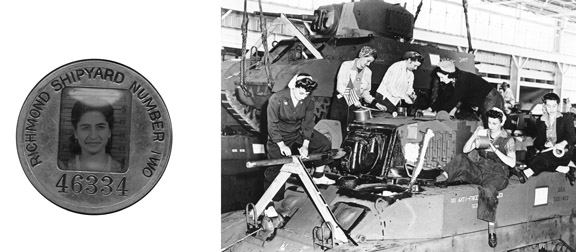The Rosie the Riveter WWII Home Front National Historical Park comprises numerous distinct sites throughout the city of Richmond. Altogether, they tell the story of a communityís war effort and production on a massive, unprecedented scale.

Published: April, 2006
The Rosie the Riveter WWII Home Front National Historical Park comprises numerous distinct sites throughout the city of Richmond. Altogether, they tell the story of a communityís war effort and production on a massive, unprecedented scale.
During WWII, 10 million civilians departed the workforce for active military service, leaving a dangerous void in home front production capabilities. In response, industry aggressively recruited and trained women and men, including minorities, who had limited job opportunities before the war, to take up the slack. They answered the call.
During WWII, Richmondís population grew from just under 24,000 to over 100,000. Rosie the Riveter was the phrase that was used to help recruit female civilian workers and, nationwide, 6 million women were mobilized to enter the workforce during WWII.
Richmond was also perfectly situated to become a strategic hub of war effort production. Many home front industrial centers were located where railroad lines met the harbors; from here, assembled and finished war material could easily be shipped overseas. Richmond Kaiser Shipyards became the largest shipbuilding operation in the U.S., producing 747 war ships with a workforce that swelled to 90,000. The Ford assembly building was converted from auto to military vehicle production, and processed over 60,000 tanks and other combat vehicles.
Today, 10,000 square feet of open space in the Ford building at Richmondís revitalized waterfront is slated to be home to the WWII Home Front Visitorís Center, replete with restaurants and retail establishments, similar to San Franciscoís ferry building.
A feasibility study, commissioned by the National Park Service, determined that national designation of Richmond would be a significant catalyst to make the WWII Home Front and Rosie the Riveter a unifying theme for the waterfront and city; [a way to] attract national and international visitors, and serve as a national education center on these important themes.
The study also found that it was not feasible for the National Park Service to acquire and manage the massive structures along the Richmond waterfront, and the open spaces, parks, trails and memorials. Therefore, unlike most National Parks, Rosie the Riveter WWII Home Front National Historical Park is made up of sites that are not owned by the National Park Service. It involves a partnership between The National Park Service, the City of Richmond and private developers and citizens. We all have to hold hands and work together in a really unique way to make it happen, said Martha Lee, the parkís general superintendent.
Indeed, the National Park Service offices are located smack-dab inside City of Richmond offices, where park service staff members work side-by-side with the cityís workers to preserve and document these historic sites. According to Lee, The City of Richmond clearly is our most important partner here.
Another goal of the National Park Service is to work closely with the community to increase awareness of the historical value of the sites that surround them.
One of the other things we are moving towards is working more closely with the schools in this area so that kids can understand the significance of this national story and their place in it. Lee said. These kids now can identify their family stories; the story of the place they live as a place the whole country is looking to, to tell that significant national story. Thatís a huge sense of pride. The story of Richmondís past is the promise of its future.
The National Park Service Wants You!
Donate your WWII Home Front memorabilia to the National Park Service. If you or someone you know has a WWII civilian home front story, photos, videos or other memorabilia about life on the home front, please contact the National Park Service. Call (800) 497-6743, or visit www.rosietheriveter.org
Photo courtesy of
National Park Service
ďRosiesĒ prepare a tank for shipment to the WWII theater of operations.

The craneway of the Ford Assembly building on Richmondís waterfront is slated to be the location of the WWII Home Front Visitors Center as well as restaurants and shops.

